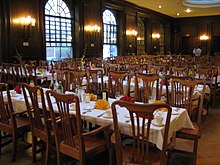Adams House (Harvard College)
| Adams House | |
|---|---|
| Residential House at Harvard University | |

The Adams House dining hall
|
|
| University | Harvard University |
| Location | 26 Plympton Street |
| Coordinates | 42°22′18″N 71°06′59″W / 42.3717°N 71.1164°WCoordinates: 42°22′18″N 71°06′59″W / 42.3717°N 71.1164°W |
| Established | 1931 |
| Named for | John Quincy Adams and the Adams family |
| Sister college | Saybrook College |
| Freshman dorm | Weld Hall |
| Faculty Deans | Judy and Sean Palfrey |
| Dean | Adam Muri-Rosenthal |
| HoCo chairs | Hannah Smati and Ryan Ward |
| Tutors | 26 |
| Website | adamshouse |
Adams House is one of twelve undergraduate residential Houses at Harvard University, located between Harvard Square and the Charles River in Cambridge, Massachusetts. Its name commemorates the services of the Adams family, including John Adams, the second president of the United States, and John Quincy Adams, the sixth president.
The residential halls of Adams House (Claverly, Randolph, Westmorly and Old Russell) were originally private "Gold Coast" dormitories built from 1893-1902 to provide luxurious accommodation for rich Harvard undergraduates. They, along with the white clapboarded Apthorp House (1760), one of the most distinguished Colonial residences of Cambridge – now the Master's residence – predate the rest of Harvard's Houses by several decades. When the House system was inaugurated in the 1930s, Old Russell was demolished and replaced with New Russell (which houses the C-entry Suites; a linking structure was also constructed that contains the upper and lower common rooms, library, conservatory, kitchen and dining areas, as well as the famous "Gold Room" — Adams' domed, tiled and gilded Mudéjar-inspired entrance hall. Although officially inaugurated in 1931, Adams was not completed until 1932. Because of its centuries-long architectural history, Adams is considered Harvard's most historic undergraduate residence.
Surprisingly, given the House’s current appeal, Adams was not popular initially; the Victorian era rooms of the Gold Coast buildings seemed dark and "Germanic" to 1930's taste, and many students preferred the entirely up-to-date neo-Colonial structures of Eliot, Winthrop and Dunster Houses. Adams' location, however, (it is the closest of all the Houses to Harvard Yard) and its reputation for good food (it is one of the few Harvard Houses that doesn't share a kitchen) soon overcame any perceived architectural deficiencies. In fact, some of these same “deficiencies” turned out to be quite handy: students in the 1940s and 1950s wishing to avoid the College's strict nightly curfews and parietal rules came to greatly value Adams' multiple and unguarded entries, unlike the central, monitored portals of the newer undergraduate residences. Today, of course, such stringent measures are long gone, and the various buildings that comprise Adams House are considered some of the most interesting and architecturally significant structures in the University system.
...
Wikipedia
